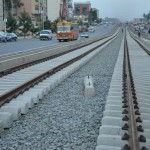 Monday 8am: it’s peak hour as I approach the roadside. The new Chinese bitumen (asphalt) may have swallowed the potholes of Bole Road, but the traffic is as crazy as ever. Cars weave erratically across five lanes and jostle for space amid the clamour of police whistles, relentless honking, and noisy construction sites. Within a few moments, a minibus taxi swings into view, the conductor shouting “Bole, Bole” through the open window.
Monday 8am: it’s peak hour as I approach the roadside. The new Chinese bitumen (asphalt) may have swallowed the potholes of Bole Road, but the traffic is as crazy as ever. Cars weave erratically across five lanes and jostle for space amid the clamour of police whistles, relentless honking, and noisy construction sites. Within a few moments, a minibus taxi swings into view, the conductor shouting “Bole, Bole” through the open window.
The ubiquitous blue and white Toyota HiAce or “blue donkey” is the main form of public transport in the Ethopian capital, Addis Ababa. I jump into the battered van and squeeze between some commuters on to a worn and dusty seat as the driver speeds off. I rummage through my pockets for the 1.5 birr (5p) fare as passengers clamber on and off at regular intervals before we reach the Bole bridge bus terminal.
My next ride takes me to Meganegna, where a crater in the ground marks the future pathway of the light rail system. Here I seek to board another minibus taxi, but there is some confusion as government officials argue with taxi drivers and station co-ordinators over routes and passenger loads. Eventually the dispute is settled and I jump on to the third minibus taxi, which will round off my daily commute …
The informal minibus taxi network in Addis comprises thousands of independent taxi operators serving a multitude of diverse routes – essentially, unofficial bus routes – and who will often pick up or drop off passengers on an ad hoc basis. The majority of routes consist of short return-journeys, and operators determine which routes and hours they will serve within a zoning system. The result is a demand-driven public transport system that operates without routes maps, timetables or central co-ordination.
The seemingly chaotic nature of this network conceals what is actually a surprisingly adaptive and responsive system. For example, operators can modify routes instantly to avoid construction zones or traffic congestion. In addition, major disruptions are usually confined to individual routes and do not spill over into the rest of the network, due to its web-like composition.
In this way, Addis’s minibus taxi network exhibits many of the attributes of a complex-adaptive system. This means it is difficult to predict and control the behaviour of the system and its actors, and not surprising that efforts to regulate the network through promotion of taxi associations, introduction of a zoning system and enforcement of maximum passenger loads have had very mixed results in the face of resistance from operators.




























Join Conversations